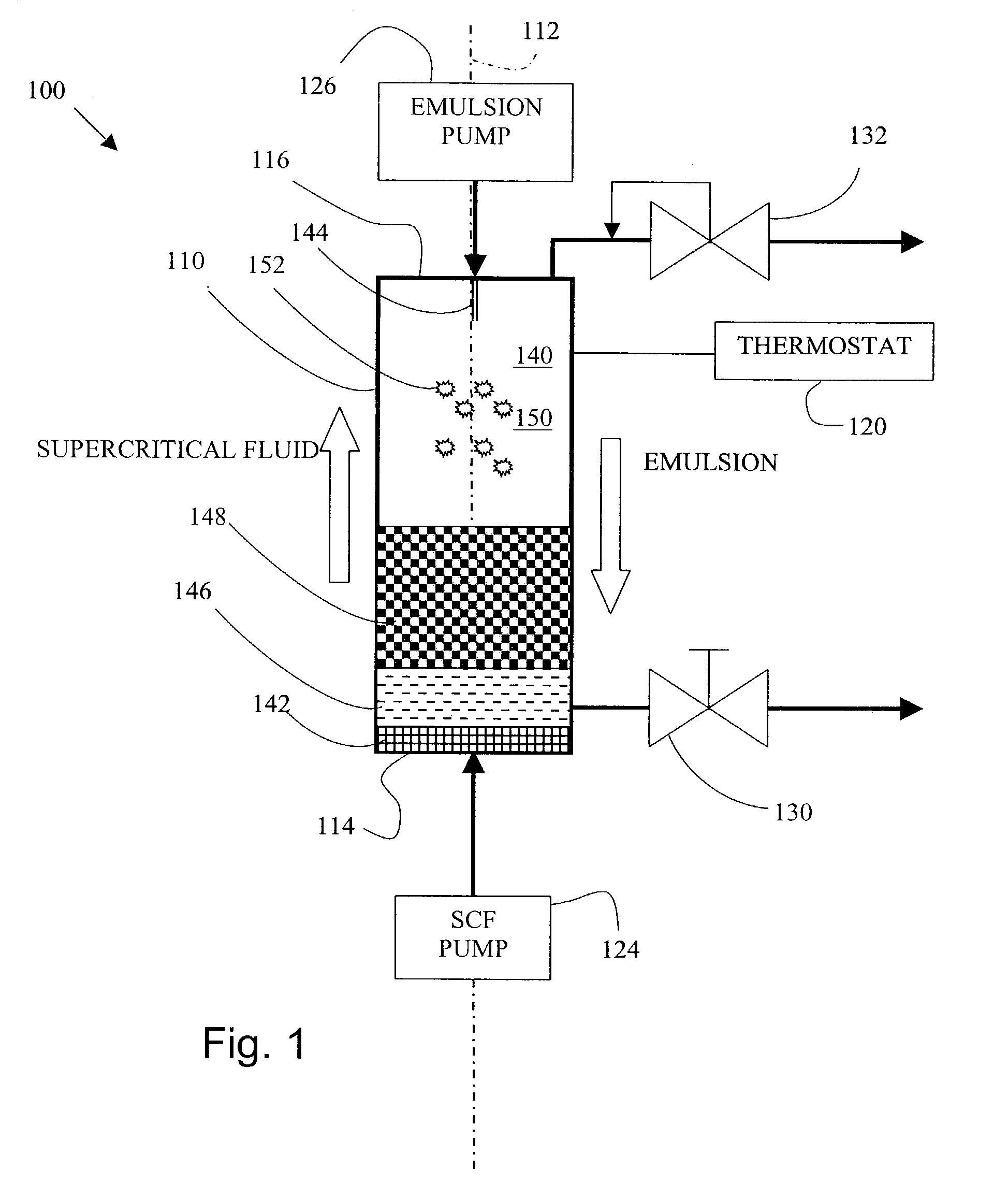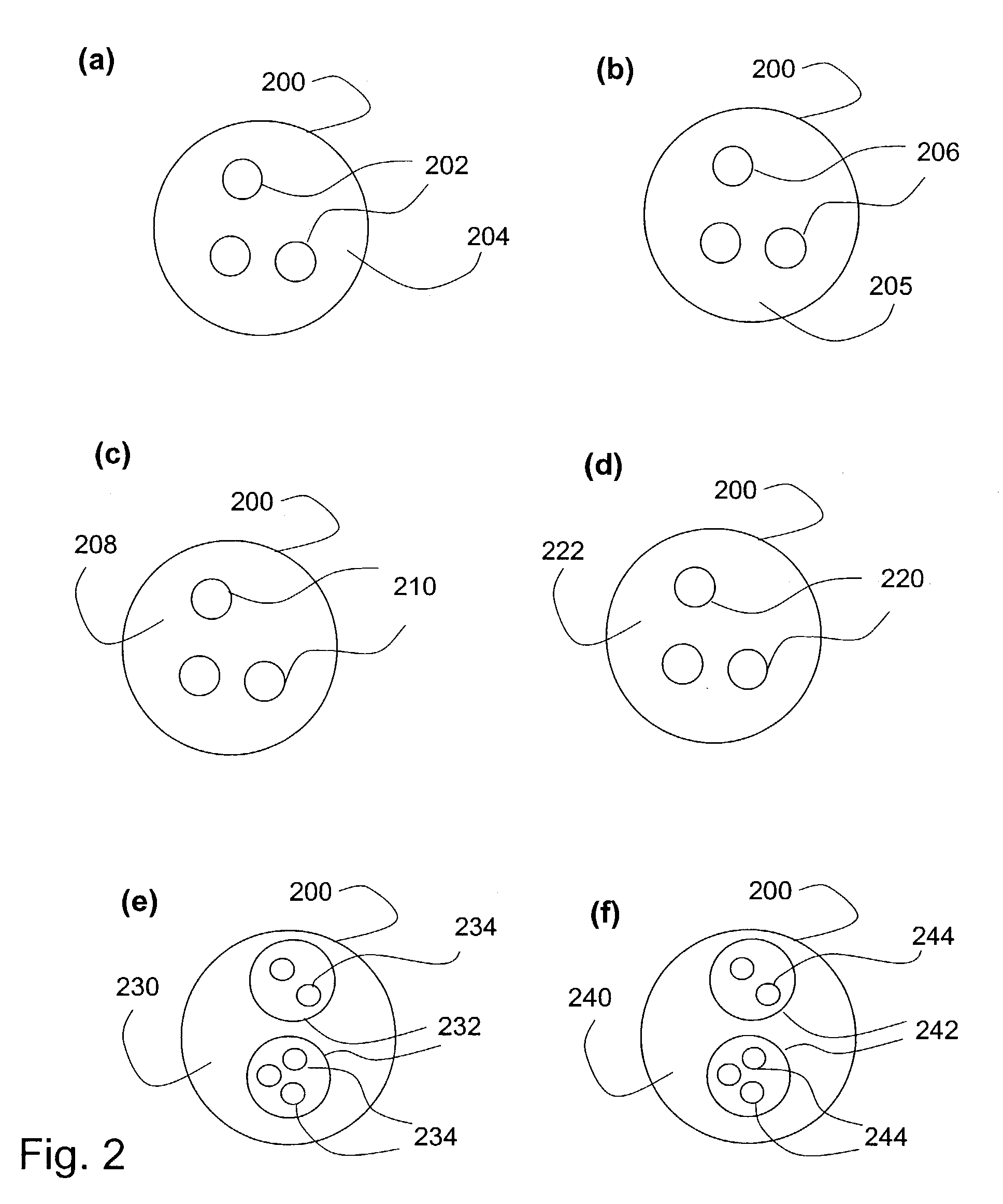Method and apparatus for continuous particle production using supercritical fluid
a supercritical fluid and particle technology, applied in the direction of biocide, separation process, other chemical processes, etc., can solve the problems of limited application, poor particle size control and uniformity of the techniques mentioned above, and limitation caused
- Summary
- Abstract
- Description
- Claims
- Application Information
AI Technical Summary
Problems solved by technology
Method used
Image
Examples
example 1
Preparation of Poly(lactide)-glycolide (PLGA) Particles Via a Method According to the Invention
[0087]Preparation of Poly(lactide)-glycolide (PLGA) Emulsion.
[0088]Ethyl Acetate (EA) was saturated with water to form a water-saturated EA solution. 20.0 grams of the saturated EA solution was measured. Into the 20.0 grams of ethyl acetate saturated solution was added 2.0 grams of Poly(lactide)-glycolide (PLGA). PLGA is commercially available from Birmingham Polymers, Inc. (Birmingham, Ala.) or Alkermes, Inc. (Cambridge, Mass.). The PLGA was dissolved into the saturated ethyl acetate solution to form a PLGA solution.
[0089]Distilled water was saturated with EA to form saturated aqueous solution. 180 g of EA saturated aqueous solution was measured. Polyvinyl alcohol (PVA) was dissolved into the portion of the ethyl acetate saturated aqueous solution at an amount of 0.5% by weight.
[0090]The PLGA solution was added into 180 grams of the EA saturated aqueous PVA solution to form a mixture. The...
example 2
Preparation of Poly(lactide)-glycolide (PLGA) Nanoparticles Via a Method According to the Invention, EXAMPLES 1–2 Show a Relationship Between Emulsion Droplet Size and Resultant Particle Size
[0096]Preparation of PLGA Emulsion.
[0097]The emulsion was prepared in the same manner as in EXAMPLE 1, except that the final homogenization step was performed at 14,500 p.s.i. in 2 passes.
[0098]Precipitation of PLGA Nanoparticles.
[0099]The precipitation of PLGA particles was carried out in the same manner as in EXAMPLE 1.
[0100]Analysis of the PLGA Particles.
[0101]The PLGA particle in EXAMPLE 2 had a different size in comparison to the PLGA particles of EXAMPLE 1. The SEM micrographs show that the PLGA particles were spherical and mono-dispersed. PLGA particles having a mean volume size of 216 nm were obtained. The results of the number and volume distributions are listed in TABLE 3.
example 3
Preparation of Cholesterol Acetate (CA) Particles Via a Method According to the Invention
[0102]Preparation of Cholesterol Acetate (CA) Emulsion.
[0103]The emulsion was prepared in the same manner as in EXAMPLE 2, except that 1.0 gram of CA was used rather than 2.0 grams of PLGA. The emulsion is this case was emulsified using a dispersator instead of a homogenizer at 5000 rpm for 3 minutes.
[0104]Precipitation of CA Nanoparticles.
[0105]The precipitation of CA particles was carried out in the same manner as the precipitation method described in EXAMPLES 1 and 2.
[0106]Analysis of the CA Nanoparticles.
[0107]Analysis of the aqueous colloidal suspension of CA particles obtained from the EXAMPLE 3 was performed using the same SEM and DLS techniques as described above. The particle size is different than the PLGA particles of EXAMPLES 1 and 2 and is listed in TABLE 3. SEM micrographs showed mono-dispersed spherical particles. Residual solvent content in the aqueous suspensions was determined ...
PUM
| Property | Measurement | Unit |
|---|---|---|
| diameter | aaaaa | aaaaa |
| diameter | aaaaa | aaaaa |
| lengths | aaaaa | aaaaa |
Abstract
Description
Claims
Application Information
 Login to View More
Login to View More - R&D
- Intellectual Property
- Life Sciences
- Materials
- Tech Scout
- Unparalleled Data Quality
- Higher Quality Content
- 60% Fewer Hallucinations
Browse by: Latest US Patents, China's latest patents, Technical Efficacy Thesaurus, Application Domain, Technology Topic, Popular Technical Reports.
© 2025 PatSnap. All rights reserved.Legal|Privacy policy|Modern Slavery Act Transparency Statement|Sitemap|About US| Contact US: help@patsnap.com



